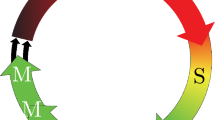Abstract
A modified version of a previously developed mathematical model [Obeyesekere et al., Cell Prolif. (1997)] of the G1-phase of the cell cycle is presented. This model describes the regulation of the G1-phase that includes the interactions of the nuclear proteins, RB, cyclin E, cyclin D, cdk2, cdk4 and E2F. The effects of the growth factors on cyclin D synthesis under saturated or unsaturated growth factor conditions are investigated based on this model. The solutions to this model (a system of nonlinear ordinary differential equations) are discussed with respect to existing experiments. Predictions based on mathematical analysis of this model are presented. In particular, results are presented on the existence of two stablesolutions, i. e., bistability within the G1-phase. It is shown that this bistability exists under unsaturated growth factor concentration levels. This phenomenon is very noticeable if the efficiency of the signal transduction, initiated by the growth factors leading to cyclin D synthesis, is low. The biological significance of this result as well as possible experimental designs to test these predictions are presented.
Similar content being viewed by others
References
Chen, Y., E. S. Knudsen and J. Y. Wang (1996). Cells arrested in G1 by the v-Abl tyrosine kinase do not express cyclin A despite the hyperphosphorylation of RB. J. Biol. Chem. 271, 19637–19640.
DeGregori, J., T. Kowalik and J. R. Nevins (1995). Cellular targets for activation by the E2F1 transcription factor include DNA synthesis and G1/S-regulatory genes. Mol. Cell. Biol. 15, 4215–4224.
Doedel, E. J., A. R. Champneys, T. F. Fairgrieve, Y. A. Kuznetsov, B. Sandstede and X. Wang (1997). AUTO 97: Continuation and Bifurcation Software for Ordinary Differential Equations (with HomCont).
Goldbeter, A. (1991). A minimal cascade model for the mitotic oscillator involving cyclin and cdc2 kinase. Proc. Natl. Acad. Sci. U. S. A. 88, 9107–9111.
Hatzimanikatis, V., K. H. Lee, W. A. Renner and J. E. Bailey (1995). A mathematical model for the G1/S transition of the Mammalian Cell Cycle. BioTechnol. Lett. 17, 669–674.
Herrera, R. E., V. P. Sah, B. O. Williams, T. P. Mäkelä, R. A. Weinberg and T. Jacks (1996). Altered cell cycle kinetics, gene expression, and G1 restriction point regulation in RB-deficient fibroblasts. Mol. Cell. Biol. 16, 2402–2407.
Hunter, T. and J. Pines (1995). Cyclins and cancer. II: cyclin D and CDK inhibitors come of age. Cell 79, 573–582.
Hyver, C. and H. Le Guyader (1990). MPF and cyclin: modelling of the cell cycle. Biosystems 24, 85–90.
Johnson, D. G., W. D. Cress, L. Jakoi and J. R. Nevins (1994). Oncogenic capacity of the E2F1 gene. Proc. Natl. Acad. Sci. U. S. A. 91, 12823–12827.
Johnson, D. G., J. K. Schwarz, W. D. Cress and J. R. Nevins (1993). Expression of transcription factor E2F1 induces quiescent cells to enter S phase. Nature 365, 349–352.
Kohn, K. W. (1998). Functional capabilities of molecular network components controlling the mammalian G1/S cell cycle phase transition. Oncogene 16, 1065–1075.
Lukas, J., T. Herzinger, K. Hansen, M. C. Moroni, D. Resnitsky, K. Helin, S. I. Reed and J. Bartek (1997). Cyclin E-induced S phase without activation of the pRB/E2F pathway. Genes Dev. 11, 1479–1492.
Nevins, J. R. (1992). E2F: a link between the RB tumor suppressor protein and viral oncoproteins. Science 258, 424–429.
Nevins, J. R. (1998). Toward an understanding of the functional complexity of the E2F and Retinoblastoma families. Cell Growth and Diff. 9, 585–593.
Norel, R. and Z. Agur (1991). A model for the adjustment of the mitotic clock by cyclin and MPF levels. Science 251, 1076–1078.
Novak, B. and J. J. Tyson (1995). Quantitative analysis of a molecular model of the mitotic control in fission yeast. J. Theor. Biol. 173, 283–305.
Obeyesekere, M. N, J. R. Herbert and S. O. Zimmerman (1995). A model of the G1 phase of the cell cycle incorporating cyclin E/cdk2 complex and Retinoblastoma protein. Oncogene 11, 1199–1205.
Obeyesekere, M. N., E. S. Knudsen, J. Y. J. Wang and S. O. Zimmerman (1997). A mathematical model of the regulation of the G1 phase of RB+/+ and RB−/− mouse embryonic fibroblasts and an osteosarcoma cell line. Cell Prolif. 30, 171–194.
Obeyesekere, M. N., S. L. Tucker and S. O. Zimmerman (1994). A model for regulation of the cell cycle incorporating cyclin A, cyclin B and their complexes. Cell Prolif. 27, 105–113.
Ohtsubo, M., A. M. Theodoras, J. Schumacher, J. M. Roberts and M. Pagano (1995). Human cyclin E, a nuclear protein essential for the G1-to-S phase transition. Mol. Cell. Biol. 15, 2612–2624.
Romond, P. C., J. M. Guilmot and A. Goldbeter (1994). The mitotic oscillator: temporal self-organization in a phosphorylation-dephosphorylation enzymatic cascade. Ber. Bunsenges. Phys. Chem. 98, 1152–1159.
Thron, C. D. (1991). Mathematical analysis of a model of the mitotic clock. Science 254, 122–123.
Thron, C. D. (1994). Theoretical dynamics of the cyclin B—MPF system: a possible role for p13suc1. BioSys. 32, 97–109.
Thron, C. D. (1997). Bistable biochemical switching and the control of the events of the cell cycle. Oncogene 15, 317–325.
Tyson, J. J. (1991). Modeling the cell division cycle: cdc2 and cyclin interactions. Proc. Natl. Acad. Sci. U. S. A. 88, 7328–7332.
Tyson, J. J., B. Novak, K. Chen and J. Val (1995). Checkpoints in the cell cycle from a modeler’s perspective. Prog. Cell Cycle Res. 1, 1–8.
Wang, J. Y., E. S. Knudsen and P. J. Welch (1994). The Retinoblastoma tumor suppressor protein. Adv. Canc. Res. 64, 25–85.
Weinberg, R. A. (1995). The Retinoblastoma protein and cell cycle control. Cell 81, 323–330.
Author information
Authors and Affiliations
Corresponding author
Rights and permissions
About this article
Cite this article
Obeyesekere, M.N., Zimmerman, S.O., Tecarro, E.S. et al. A model of cell cycle behavior dominated by kinetics of a pathway stimulated by growth factors. Bull. Math. Biol. 61, 917–934 (1999). https://doi.org/10.1006/bulm.1999.0118
Received:
Accepted:
Issue Date:
DOI: https://doi.org/10.1006/bulm.1999.0118




